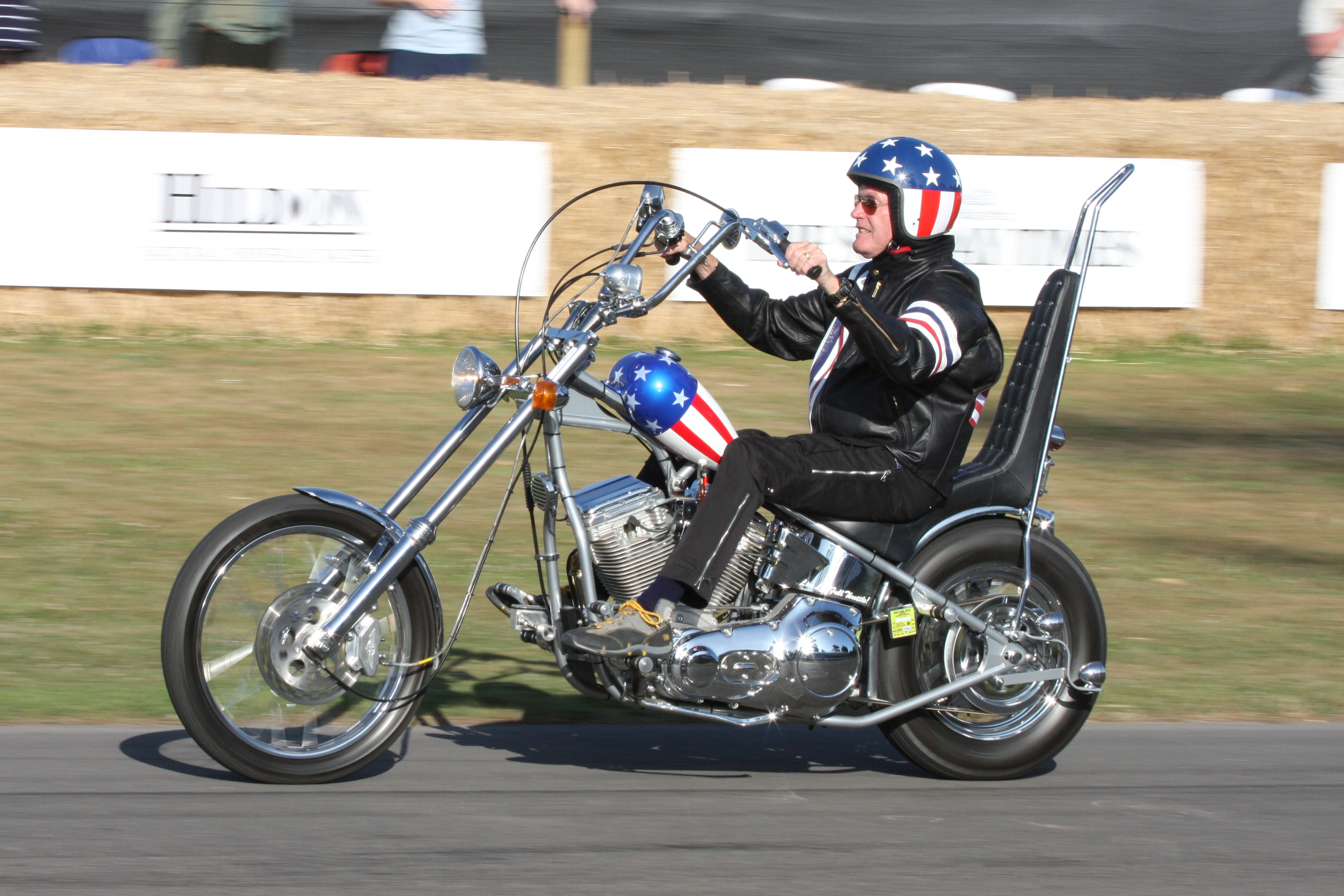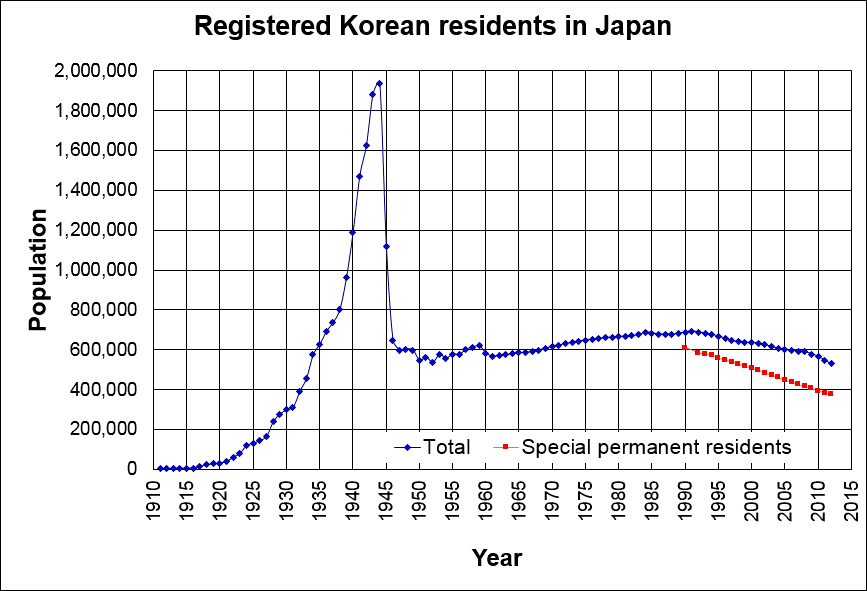|
Bōsōzoku
is a Japanese youth subculture associated with customized motorcycles. The first appearance of these types of biker gangs was in the 1950s. Popularity climbed throughout the 1980s and 1990s, peaking at an estimated 42,510 members in 1982. Their numbers dropped dramatically in the 2000s, with fewer than 7,297 members in 2012. style traditionally involves boilersuits similar to those of manual laborers or leather military jackets with baggy pants, and tall boots. This uniform became known as the and is often adorned with kanji slogans. Typical accessories to this uniform are , surgical masks, and patches displaying the Rising Sun Flag. members are known for taking a Japanese road bike and adding modifications such as over-sized fairings, lifted handle bars shifted inwards, large seat backs, extravagant paint jobs, and modified mufflers. styles take inspiration from choppers, greasers, and Teddy boys. History first started as groups of returning World War II veterans. T ... [...More Info...] [...Related Items...] OR: [Wikipedia] [Google] [Baidu] |
Tasuki (sash)
A is a fashion accessory used for holding up the long sleeves of the Japanese kimono. It is a sash made from either cloth or cord that loops over each shoulder and crosses over the wearer's back. The bottom of the kimono sleeves can then be tucked into the loop, holding them back for convenience and functionality. Overview In modern Japanese history, were used by many people as everyday practical accessories, but in ancient Japan they were an exclusive accessory used by the Shinto clergy during ceremonies. Terracotta Haniwa dating to the Kofun period that were excavated in Gunma Prefecture depict Shinto wearing . During the Edo period (1603-1867), were worn by manual laborers for the mobility they would have had if they were not wearing kimono. The allowed the kimono wearer to work without large sleeves getting in the way of the job, and without risking damage to the garment's sleeves. are still used for both practical and aesthetic reasons even for modern wearers of ... [...More Info...] [...Related Items...] OR: [Wikipedia] [Google] [Baidu] |
Mod (subculture)
Mod, from the word modernist, is a subculture that began in London and spread throughout Great Britain and elsewhere, eventually influencing fashions and trends in other countries, and continues today on a smaller scale. Focused on music and fashion, the subculture has its roots in a small group of stylish London-based young men in the late 1950s who were termed ''modernists'' because they listened to modern jazz. Elements of the mod subculture include fashion (often tailor-made suits); music (including soul, rhythm and blues, ska and mainly jazz) and motor scooters (usually Lambretta or Vespa). In the mid-1960s, the subculture listened to power pop rock groups with mod following, such as the Who and Small Faces, after the peak Mod era. The original mod scene was associated with amphetamine-fuelled all-night jazz dancing at clubs. During the early to mid-1960s, as mod grew and spread throughout the UK, certain elements of the mod scene became engaged in well-publicised cla ... [...More Info...] [...Related Items...] OR: [Wikipedia] [Google] [Baidu] |
Yakuza
, also known as , are members of transnational organized crime syndicates originating in Japan. The Japanese police and media, by request of the police, call them , while the ''yakuza'' call themselves . The English equivalent for the term ''yakuza'' is gangster, meaning an individual involved in a Mafia-like criminal organization. The ''yakuza'' are known for their strict codes of conduct, their organized fiefdom nature and several unconventional ritual practices such as '' yubitsume'' or amputation of the left little finger. Members are often portrayed as males, wearing "sharp suits" with heavily tattooed bodies and slicked hair. This group is still regarded as being among "the most sophisticated and wealthiest criminal organizations". At their height, the ''yakuza'' maintained a large presence in the Japanese media and operated internationally. At their peak in the early 1960s, police estimated that the ''yakuza'' had a membership of more than 200,000."Police of Japa ... [...More Info...] [...Related Items...] OR: [Wikipedia] [Google] [Baidu] |
Greaser (subculture)
Greasers are a youth subculture that emerged in the 1950s and early 1960s from predominantly working class and lower-class teenagers and young adults in the United States. The subculture remained prominent into the mid-1960s and was particularly embraced by certain ethnic groups in urban areas, particularly Italian Americans and Latino Americans. History Etymology of the term greaser The etymology for the term ''greaser'' is unknown. It is speculated that the word originated in the late 19th century in the United States as a derogatory label for poor laborers, specifically those of Italian, Greek or Mexican descent. The similar term "greaseball" is a slur for individuals of Italian or Greek descent, though to a lesser extent it has also been used more generally to refer to all Mediterranean, Latino, or Hispanic people. By the time of the Civil War, the word was understood to carry racist and segregationist meanings. It was later used to reference automotive mechanics. ... [...More Info...] [...Related Items...] OR: [Wikipedia] [Google] [Baidu] |
Mat Rempit
A Mat Rempit is a Malaysian term for "an individual who participates in activities such as illegal street racing, bike stunt performance, petty crime and public disturbance using a motorcycle", usually involving 2- and 4-stroke underbone motorcycles, colloquially known as ''Kapcai'' or scooters. Mat Rempits are often seen on Malaysian streets, where they would gather in groups and race against each other for cheap thrills such as races and stunts (such as the wheelie, superman (lying flat on the seat), wikang and scorpion (standing on the seat with one leg during a wheelie). However, there are cases where they openly rebel against authorities where they would run through roadblocks, ride against the traffic or hit police officers with their bikes. Mat Rempits often race or perform stunts without proper safety gear and properly-equipped bikes, which often lead to accidents, causing major injuries or death. Etymology The word "Rempit" comes from "ramp-(rev)-it" (ramp the thrott ... [...More Info...] [...Related Items...] OR: [Wikipedia] [Google] [Baidu] |
Raggare
Raggare is a subculture found mostly in Sweden and parts of Norway and Finland, and to a lesser extent in Denmark, Germany, and Austria. Raggare are related to the American greaser and rockabilly subcultures and are known for their love of hot rod cars and 1950s American pop culture. Loosely translated into English, the term is roughly equivalent to the American "greaser", English "rocker", and Australian " Bodgie" and "Widgie" culture; all share a common passion for mid-20th-century American cars, rockabilly-based music and related fashion (blue-collar in origin, consisting of the likes of white T-shirts, loose fitting denim trousers with rolled cuffs, and canvas top sneakers such as Keds or Converse Chucks, or low-topped boots of an industrial nature). While the raggare movement has its roots in late 1950s youth counterculture, today it is associated mainly with middle-aged men who enjoy meeting and showing off their retro American cars. However, the subculture retai ... [...More Info...] [...Related Items...] OR: [Wikipedia] [Google] [Baidu] |
Outlaw Motorcycle Club
An outlaw motorcycle club is a motorcycle subculture generally centered on the use of cruiser motorcycles, particularly Harley-Davidsons and choppers, and a set of ideals that purport to celebrate freedom, nonconformity to mainstream culture, and loyalty to the biker group. In the United States, such motorcycle clubs (MCs) are considered "outlaw" not necessarily because they engage in criminal activity, but because they are not sanctioned by the American Motorcyclist Association (AMA) and do not adhere to the AMA's rules. Instead, the clubs have their own set of bylaws reflecting the outlaw biker culture. The U.S. Department of Justice defines "outlaw motorcycle gangs" (OMG) as "organizations whose members use their motorcycle clubs as conduits for criminal enterprises". Organization and leadership While organizations may vary, the typical internal organization of a motorcycle club consists of a president, vice president, treasurer, secretary, road captain, and serg ... [...More Info...] [...Related Items...] OR: [Wikipedia] [Google] [Baidu] |
Scooter (motorcycle)
A scooter (motor scooter) is a motorcycle with an underbone or step-through frame, a seat, and a platform for the rider's feet, emphasizing comfort and fuel economy in automobiles, fuel economy. Elements of scooter design were present in some of the earliest motorcycles, and motor scooters have been made since at least 1914. The global popularity of motor scooters dates from the post-World War II introductions of the Vespa and Lambretta models in Italy. These scooters were intended to provide economical personal transportation (engines from ). The original layout is still widely used in this application. Maxi-scooters, with larger engines from have been developed for Western markets. Scooters are popular for personal transportation partly due to being more affordable, easier to operate, and more convenient to park and store than a car. Licensing requirements for scooters are easier and cheaper than for cars in most parts of the world, and insurance is usually cheaper. The te ... [...More Info...] [...Related Items...] OR: [Wikipedia] [Google] [Baidu] |
Chopper (motorcycle)
A chopper is a type of custom motorcycle which emerged in the US state of California in the late 1950s. A chopper employs radically modified steering angles and lengthened forks for a stretched-out appearance. They can be built from an original motorcycle which is modified ("chopped") or built from scratch. Some of the characteristic features of choppers are long front ends with extended forks often coupled with an increased rake angle, hardtail frames (frames without rear suspension), very tall "ape hanger" or very short "drag" handlebars, lengthened or stretched frames, and larger than stock front wheels. The "sissy bar", a set of tubes that connect the rear fender with the frame, and which are often extended several feet high, is a signature feature on many choppers. Two famous examples of the chopper are customised Harley-Davidsons, the "Captain America (motorcycle), Captain America" and "Billy Bike", seen in the 1969 film ''Easy Rider''. History The Bob-Job Era, 1946–1 ... [...More Info...] [...Related Items...] OR: [Wikipedia] [Google] [Baidu] |
Zainichi
comprise ethnic Koreans who have permanent residency status in Japan or who have become Japanese citizens, and whose immigration to Japan originated before 1945, or who are descendants of those immigrants. They are a group distinct from South Korean nationals who have emigrated to Japan after the end of World War II and the division of Korea. They currently constitute the second largest ethnic minority group in Japan after Chinese immigrants, due to many Koreans assimilating into the general Japanese population. The majority of Koreans in Japan are , often known simply as , who are ethnic Korean permanent residents of Japan. The term Zainichi Korean refers only to long-term Korean residents of Japan who trace their roots to Korea under Japanese rule, distinguishing them from the later wave of Korean migrants who came mostly in the 1980s, and from pre-modern immigrants dating back to antiquity who may themselves be the ancestors of the Japanese people. The Japanese word "Zaini ... [...More Info...] [...Related Items...] OR: [Wikipedia] [Google] [Baidu] |
Burakumin
is a name for a low-status social group in Japan. It is a term for ethnic Japanese people with occupations considered as being associated with , such as executioners, undertakers, slaughterhouse workers, butchers, or tanners. During Japan's feudal era, acquired a hereditary status of untouchability, and became an unofficial caste of the Tokugawa class system during the Edo period. were victims of severe discrimination and ostracism in Japanese society, and lived as outcasts, in their own separate villages or ghettos. status was abolished officially after the Meiji Restoration in 1868, but the descendants of have since continued to experience stigmatization and discrimination in Japan. Terminology is derived from , a Japanese term which refers literally to a small, generally rural, commune or hamlet. People from regions of Japan where "discriminated communities" no longer exist (e.g. anywhere north of Tokyo) may refer to any hamlet as a , indicating use of the wor ... [...More Info...] [...Related Items...] OR: [Wikipedia] [Google] [Baidu] |










